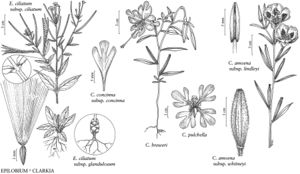Epilobium ciliatum subsp. ciliatum
Herbs usually with leafy basal rosettes, with subovate, obtuse, subentire leaves 15–35 mm, rarely fleshy turions. Stems (3–)10–120(–190) cm, usually well branched especially distally, rarely simple, subglabrous proximal to inflorescence with raised strigillose lines from margins of petioles, ± densely mixed strigillose and glandular puberulent distally, rarely densely villous throughout. Leaves: petiole 0–5(–8) mm; blade narrowly obovate to spatulate proximally, very narrowly lanceolate to narrowly ovate or elliptic distally, (1–)3–12 × (0.3–)0.6–3.7 cm, apex obtuse proximally to acute distally; bracts very reduced and narrower. Inflorescences usually erect, rarely nodding, racemes or panicles, open, not congested. Flowers: floral tube 0.5–1.8 × 0.9–3 mm; sepals 2–6 × 0.7–1.6 mm; petals white or sometimes pink, 2–6(–9) × 1.3–4 mm; filaments white or pink, those of longer stamens 1.4–4.8 mm, those of shorter ones 0.6–2.6 mm; style 1.1–6.5 mm, stigma 0.8–2.2 × 0.4–0.9 mm. Capsules (15–)30–100 mm, surfaces usually strigillose and glandular puberulent, rarely glabrescent; pedicel 2–15(–40) mm, rarely subsessile. Seeds (0.6–)0.8–1.2(–1.4) × 0.3–0.5 mm, chalazal collar 0.02–0.2 × 0.1–0.3 mm; coma very rarely absent. 2n = 36.
Phenology: Flowering Jun–Oct(–Nov).
Habitat: Disturbed, open, mesic areas, along roadsides, stream banks, lake margins, seeps, coastal bluffs.
Elevation: 0–4200 m.
Distribution
Alta., B.C., Man., N.B., Nfld. and Labr., N.W.T., N.S., Ont., P.E.I., Que., Sask., Yukon, Alaska, Ariz., Calif., Colo., Conn., Del., Idaho, Ill., Ind., Iowa, Kans., Ky., Maine, Md., Mass., Mich., Minn., Mo., Mont., Nebr., Nev., N.H., N.J., N.Mex., N.Y., N.C., N.Dak., Ohio, Okla., Oreg., Pa., R.I., S.C., S.Dak., Tenn., Tex., Utah, Vt., Va., Wash., W.Va., Wis., Wyo., Mexico, Central America (Guatemala), South America (Argentina, Chile), Asia (China, Japan, Korea, Russian Far East), introduced in Europe, Pacific Islands (Hawaii, New Zealand), Australia.
Discussion
Subspecies ciliatum is the most widely distributed and common taxon in the genus, both in areas where it is native, and in those where it has become naturalized. The extensive synonymy of this taxon reflects its abundance in a wide ecogeographical range, and its extreme variability. Compared to most other taxa of Epilobium, subsp. ciliatum shows a very high degree of phenotypic plasticity, especially in plant size and branching, leaf size and shape, patterns of vestiture, and flower size and color. This plasticity, coupled with its persistent autogamy and high seed set, produces many diverse local and/or regional phenotypes, some of which have been segregated and named in the past. However, many intermediates also occur, and growing even very distinctive phenotypes in a common garden produces nearly indistinguishable plants with morphology typical for the subspecies. Some notable regional variants treated here in synonymy include E. holosericeum in southern California and occasionally elsewhere, which has densely sericeous pubescence throughout an otherwise typical plant of subsp. ciliatum, and E. ecomosum, found in southern Quebec in Canada along the St. Lawrence River, comprised of plants typical of subsp. ciliatum save their ecomose seeds. Ecomose seeds also characterize the annual sects. Pachydium and Epilobiopsis, but are known in sect. Epilobium only in E. curtisiae P. H. Raven from New Zealand. This treatment adopts a broad delimitation of taxa, despite such apparently distinctive variants, in part because plants with similar but slightly differing character combinations occur scattered through the wide range of the subspecies, and in part because a narrow species definition would require recognition of many additional regional taxa with slightly differing character combinations that would be very difficult to define and distinguish, and would obscure the overriding integrity of subsp. ciliatum.
Subspecies ciliatum occurs sympatrically with many other species of Epilobium and hybridizes with most, as evidenced by the low but persistent occurrence of apparent hybrids on herbarium sheets. Experimental hybrids between subsp. ciliatum and numerous other species (P. H. Raven and T. E. Raven 1976; S. R. Seavey and P. H. Raven 1977, 1977b, 1978) produce vigorous plants, often with reduced seed fertility. Even low levels of introgression following hybridization may account for some of the variation found in this taxon.
Epilobium palmeri H. Léveillé is an illegitimate name that pertains here.
Selected References
None.
